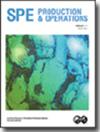Experimental Studies on Demulsification of Heavy Crude Oil-in-Water Emulsions by Chemicals, Heating, and Centrifuging
IF 1.3
4区 工程技术
Q2 ENGINEERING, PETROLEUM
引用次数: 6
Abstract
The development of concentrated and highly stable oil-in-water (O/W) emulsion is considered to be a cost-effective alternative for the transportation of produced heavy crude oils. However, the demulsification of a transported O/W emulsion is necessary once it reaches the destination. This article experimentally investigates the performance of four low-cost chemicals of varying water solubility as potential demulsifiers, independently and in combinations, for demulsifying two Indian heavy crude O/W emulsions prepared for pipeline transportation. The chemical demulsifiers used, in order of their higher water solubility, are: polyethylene glycol 400 (PEG) > polyoxyethylene (20) sorbitan monooleate (Tween-80) > linear alkylbenzene sulfonic acid (LABSA) > n-octylamine (OA). For this study, stable O/W emulsions (in the 60:40 ratio) of two Indian heavy crude oils were prepared using high-frequency ultrasonic waves in the presence of Triton X-100 as a surfactant. Both crude oils were characterized at first based on their physicochemical properties, infrared (IR) spectrum, and rheological properties. Prepared O/W emulsions were characterized based on rheological properties and droplet size. A bottle test method with heating (using a water bath) and enhanced gravity (by centrifuge) has been used to study the demulsification efficiency of used chemicals. Complete demulsification of both emulsions was achieved as desired. The synergetic effect of the interaction between two suitable demulsifiers provided remarkably better performance than that of independent returns, leading to minimization of the amount of demulsifier and the energy requirement for complete demulsification of both emulsions.化学法、加热法和离心法对水中稠油乳状液破乳的实验研究
开发浓缩且高度稳定的水包油(O/W)乳液被认为是运输生产的重质原油的一种具有成本效益的替代方案。然而,一旦输送的O/W乳液到达目的地,就必须对其进行破乳。本文通过实验研究了四种不同水溶性的低成本化学品作为潜在破乳剂的性能,分别或组合使用,用于破乳两种用于管道运输的印度重质原油O/W乳液。所用的化学破乳剂,按其较高的水溶性顺序为:聚乙二醇400(PEG) > 聚氧乙烯(20)山梨醇单油酸酯(吐温-80) > 线性烷基苯磺酸 > 正辛胺(OA)。在本研究中,在Triton X-100作为表面活性剂的存在下,使用高频超声波制备了两种印度重质原油的稳定O/W乳液(60:40比例)。这两种原油首先根据其理化性质、红外光谱和流变性质进行了表征。基于流变特性和液滴尺寸对制备的O/W乳液进行了表征。采用加热(水浴)和增强重力(离心机)的瓶子试验方法研究了用过的化学品的破乳效率。两种乳液均按要求完全破乳。两种合适的破乳剂之间相互作用的协同效应提供了明显优于独立收益的性能,从而使破乳剂的量和两种乳液完全破乳所需的能量最小化。
本文章由计算机程序翻译,如有差异,请以英文原文为准。
求助全文
约1分钟内获得全文
求助全文
来源期刊

Spe Production & Operations
工程技术-工程:石油
CiteScore
3.70
自引率
8.30%
发文量
54
审稿时长
3 months
期刊介绍:
SPE Production & Operations includes papers on production operations, artificial lift, downhole equipment, formation damage control, multiphase flow, workovers, stimulation, facility design and operations, water treatment, project management, construction methods and equipment, and related PFC systems and emerging technologies.
 求助内容:
求助内容: 应助结果提醒方式:
应助结果提醒方式:


